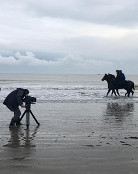Donn's Articles » Derby stallions
Derby stallions
Fashion is fleeting. The world of racing is governed by the ebbs and flows of tastes and trends as much as the world of, well, fashion. Trainers and jockeys and races and stallions can fall in or out of vogue as easily as leg warmers or the grandfather shirt.
The institution that is the Epsom Derby is not immune. It is not so long ago that the Derby stood head and shoulders above every other race on the calendar in terms of prestige and proceeds, the most coveted prize in the world of thoroughbred racing. The Minstrel crystallised from a $200,000 flashy chesnut yearling into a $9 million stallion by dint of his narrow victory in the 1977 Derby, El Gran Senor would have been an $80 million stallion had his head and not Secreto’s been down on the line at the end of the 1984 Derby.
But just like other institutions these days, the Derby has been through a turbulent time. In an era during which speed and immediacy fed fickle desires more easily than stamina and longevity, the Derby was out of favour. Speed was the new black, and a Derby winner, a colt with the stamina to win a Classic over a mile and a half, was not any more an automatic addition to the wish list of commercial breeders.
There was a notable shift in the type of stallions that were prominent in the sires’ lists, from stamina-influencers like Caerleon and Ile De Bourbon and Shirley Heights and Rainbow Quest in the late 1980s and early 1990s, to milers and sprinters like Danehill and Indian Ridge and Pivotal and Green Desert and Kingmambo by the early 2000s. Sadler’s Wells was the colossus that straddled both eras, but while his stamina-influencing qualities were consistent with the trend in the early 1990s, they were an exception to it at the end of the decade.
A couple of things counted against Derby winners during that time. There was the rise of the Japanese bloodstock industry, the appetite that the Japanese developed for the improvement of the quality of their bloodstock and the fact that they honed in on the Derby as the watermark of quality, with the result that the majority of Epsom Derby winners of the 1990s were marked for export out East.
This had two effects: firstly, it removed the Derby winner from the European psyche during those key early formative years in a new stallion’s career, when breeders are developing and influencing opinions on the merits of the stallion. Secondly, it meant that the stallion’s early progeny were largely racing under unsuitable conditions. Japanese racing is generally more speed-oriented than European racing. Their ground is generally much quicker than European ground and their racing programme greatly favours precocity, factors which do not necessarily play to the strengths of an Epsom Derby winner’s progeny.
There is also a chance that we have been through two sharp dips in the quality of Derby winners in the last decade and a half. Of the six Derby winners between 1994 and 1999 inclusive, four of them didn’t win another race, while High-Rise won just once, a listed race at Nad Al Sheba, in nine more runs. Of the four Derby winners between 2003 and 2006 inclusive, Kris Kin, North Light, Motivator and Sir Percy, none of them won again in 13 collective attempts.
In between, we had the golden era of Sinndar, Galileo and High Chaparral, a rat-tat-tat of top class racehorses, all multiple Group 1 winners after the Derby. Sinndar hasn’t done too badly either in his second career, numbering Youmzain and Shawanda and the exciting three-year-old filly Rosanara among his progeny to date. High Chaparral has the likes of High Heeled and Unsung Heroine and Noll Wallop and Joanna to represent him well on this side of the world, while So You Think won the Group 1 Cox Plate at Moonee Valley last October. Galileo, of course, is one of the most successful stallions in the business these days, toe to toe with Montjeu for the mantle of successor to their own sire Sadler’s Wells.
We may have hit on another golden seam of Derby winners now. The last three, Authorized, New Approach and Sea The Stars, all won Group 1 races after their heroics at Epsom, all proving themselves against older horses. Authorized has yearlings this year, New Approach has foals, Sea The Stars has apparently been as prolific in the breeding shed as he was on the racecourse, and we eagerly await their progeny’s first steps on the racecourse.
The French caved in to the speed fad five years ago by shortening the distance of their Derby from a mile and a half to 10 and a half furlongs, but they may have been a little hasty in so doing. Initial results indicate that the quality may be suffering. The five winners to date over the new distance fall some way short of the quality exuded by winners over the previous decade, Peintre Celebre, Dream Well, Montjeu, Dalakhani and their ilk.
Of course, a thoroughbred’s quality is not solely down to stamina, but it isn’t solely down to speed either. The Epsom Derby tests both, as well as conformation and temperament. It is the quintessential test for a thoroughbred racehorse and, given the quality and the potential of the animals that are set to line up on Saturday, it looks like it is back in vogue.
© The Racing Post, 1st June 2010


 Follow Donn
Follow Donn